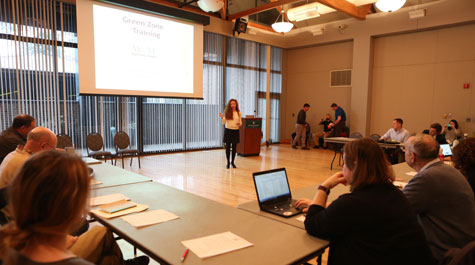New Green Zone training will support military-affiliated students
Seeking to understand and provide better support for the unique needs of military-affiliated students, William & Mary has piloted Green Zone training for faculty and staff members.
The Military and Veterans' Affairs Working Group developed the program this spring, according to chair Jackie Rodriguez, an assistant professor in the School of Education. A pilot session was held March 20 and will be tweaked for a full rollout in the fall.
Green Zone training was pioneered at Virginia Commonwealth University in 2010 and is now offered at more than 100 universities and organizations nationwide, according to VCU’s website. It is named for the secure international zone in Baghdad, Iraq, which is a place familiar to many post-9/11 service members.
Each institution tailors the program to fit its own individual needs, Rodriguez said. But the overriding idea is to create a network of supportive faculty and staff members across campus who know the concerns of and resources available for military-affiliated students.
“We as a working group collectively have a vested interest in supporting faculty and staff as they work with our military-affiliated students,” Rodriguez said. “We know that our student veterans and active duty student members on campus are oftentimes met with allyship and advocacy from faculty and staff, though every once in a while our students have an experience that is dismaying and disappointing.
“Through Green Zone training we seek to better support the faculty and staff on campus by increasing their awareness of the student veteran’s experiences, and through establishing increased communication between faculty, staff and military-affiliated students.”
W&M currently has 47 undergraduate and 210 graduate students who are either active duty, reserves or veterans in the military, which is 3 percent of the university’s enrollment. Another 918 students have a spouse, parent/legal guardian or child who has or is currently serving.
The working group’s committee that designed the W&M Green Zone program included veterans from the staff and student ranks, along with staff and graduate assistant Haley Bockhorn. The W&M Office of Diversity & Inclusion is providing support for the program.
Committee members include Charlie Foster M.Ed. ’17, a Marine Corps veteran who earned his master’s degree at the School of Education and currently serves as veteran liaison at the Troops to Teachers Virginia Center at the education school, and Kurt Klingenberger M.P.P. ’16, M.B.A. ’16, who is retired Air Force and has earned two master’s degrees at W&M and is now working on his Ph.D. at the education school. Both were presenters at the training.
“I think that there is a lot of awareness here on this campus based on where we are geographically, between several military installations,” Foster said. “We saw the data that showed how many military-affiliated students we have here. I do think we’re not talking about it as much as we could, and I definitely am excited to be moving in a direction where we’re talking about it more.”
Klingenberger said he thinks colleges should pursue enrolling military veterans for their experience.
“One of the steps along the way is to ensure that anything the College can do that says to a military veteran: ‘Please come here,’ and by the way we have some programs in place — the Green Zone — that will help either make or ensure that that’s a good experience,” he said.
The pilot session presented information on the challenges faced by students when transitioning from the military to civilian life, and especially to a college campus. Presenters focused on traits veterans may bring to college, issues they often encounter and some of the unique challenges that professors may not be aware of.
Corey York ’19, a Marine Corps veteran and president of the W&M Student Veterans Association, was a panelist.
“One of the major overarching initiatives of the Green Zone Training is to hopefully heighten awareness of staff and faculty of some of the challenges that are distinct to the veteran demographic, especially among the undergraduate-level staff and faculty who are more accustomed to dealing with the more traditional 18- to 20-year-old student,” York said. “Specifically, we're trying to bring awareness to potential issue areas like vets who live far from campus, have families, PTSD, or plainly, the challenges accompanied with transitioning from boots to books.
“These are all dynamics that are all relatively unique and yet common to this demographic. We’re trying to dispel myths, bring attention to the circumstances and to enrich some good dialogue between veterans and administrators.”
The training consisted of an initial informational segment, presentation by W&M University Ombuds and former Air Force lawyer Mark Patterson on his role at the university and a panel with three current military veteran students sharing information about themselves and taking questions.
Panel participants explained how awareness, knowledge and sensitivity about the possible issues that veteran students are dealing with could help make them more comfortable and able to perform better in their classes. For example, one described how he always sits in the upper left corner of the classroom because he’s left-handed, lost the hearing in his right ear while serving and gets anxious when other people sit behind him.
Starting in the fall, Green Zone training will be held once per semester and will be open to all faculty and staff, according to Rodriguez. The plan is to build an ever-widening network of supportive individuals on campus.
“We want military-affiliated students to know they have allies amongst the campus community,” Rodriguez said. “When faculty and staff hear of an instance where a student veteran is having difficulty, we want them to advocate on that student’s behalf and to know they have the resources to do so.”
 Skip to main content
Skip to main content

